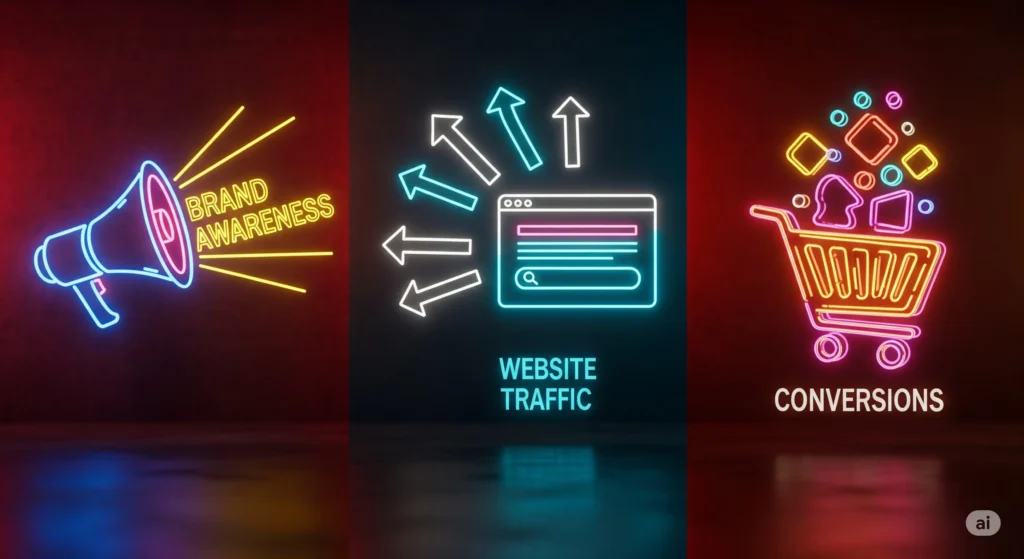Social media marketing fundamentals are the core practices that help brands plan, create, publish, and measure content across platforms to reach the right audience and drive outcomes. A solid foundation covers strategy, content pillars, channel mix, community engagement, paid amplification, and measurement. Done well, social media can build awareness, generate leads, and increase revenue in a repeatable way.
What it is and why it matters
Social media marketing is the process of using platforms like Instagram, LinkedIn, Facebook, TikTok, YouTube, and X to connect with audiences and move them from discovery to action. It blends consistent content, data-driven optimization, and community building.
The opportunity is large. As of mid‑2025, there are about 5.41 billion social media users globally—roughly two‑thirds of the world’s population—spending meaningful time on these platforms each week DataReportal. Usage continues to rise, and social often influences product discovery and purchase.
Social works best when it fits into a broader digital strategy. If you are building your overall plan, start with the bigger picture and align channels and goals with this guide to the fundamentals of digital marketing.
How it impacts businesses
Social media can:
- Build brand awareness: Reach net-new audiences with educational and entertaining content.
- Drive website traffic: Use compelling hooks and clear CTAs to send visitors to offers and landing pages.
- Generate leads and sales: Combine organic content with targeted paid campaigns and on‑platform lead forms.
- Strengthen loyalty: Engage in comments and DMs, and spotlight user‑generated content to deepen trust.
- Inform product and content: Social listening reveals topics, objections, and language your customers use.

Example: A local service brand can post short how‑to videos, share before/after stories, run a retargeting ad for a seasonal offer, and encourage reviews—then capture inbound leads through a high‑converting landing page. For landing page best practices, see these conversion-focused essentials.
A simple framework you can follow
Use this 8‑step blueprint to set up or refresh your social program.
1) Set goals and guardrails
- Choose 1–2 primary outcomes per quarter (e.g., demo requests, email signups).
- Define success metrics (e.g., CTR, cost per lead, qualified leads).
- Set a monthly budget and testing limits for paid campaigns.
2) Know your audience
- Map top customer segments, problems, and desired outcomes.
- List 10–15 questions they ask and 10–15 objections they raise.
- Identify platform fit by segment (e.g., B2B on LinkedIn/YouTube; visual DTC on Instagram/TikTok).
3) Build content pillars
- Choose 4–6 pillars that ladder up to your offer:
- Teach (how‑tos, checklists, tutorials)
- Prove (case posts, testimonials, data)
- Engage (questions, polls, trends)
- Brand (values, team, behind‑the‑scenes)
- Convert (offers, webinars, lead magnets)
- Community (UGC, customer spotlights)
If you need topic ideas that stretch your budget, try these practical content marketing ideas.
4) Create a publishing cadence
- Start with 3–5 posts/week on your primary channel and 1–3/week elsewhere.
- Batch create assets and write captions once per week.
- Keep a 2–4 week content calendar; schedule posts, but stay flexible for trends.
5) Optimize for social search
- Add relevant keywords to bios, captions, and alt text without stuffing.
- Use 3–5 focused hashtags per post.
- Include “how to,” “best,” and question formats that match user intent. HubSpot outlines the fundamentals of social strategy and optimization in this guide to building a plan that drives ROI HubSpot.
For deeper keyword discovery and search intent, use this primer on keyword research as a beginner, then adapt the language for social.
6) Engage and build community
- Reply to comments quickly; acknowledge users by name.
- Ask questions and run polls.
- Reshare UGC (with permission) and credit creators.
7) Add paid amplification
- Boost top‑performing organic posts to similar audiences.
- Build a simple funnel: prospecting (value video) → retargeting (offer) → conversion (lead form or landing page).
- Cap frequency; rotate creative weekly.
8) Measure, learn, and iterate
- Review weekly: hooks, thumbnails, watch time, CTR.
- Review monthly: CPA/CPL, conversion rate, net new leads.
- Keep a living “wins” board: high‑performing hooks, formats, and offers.
Quick-start checklist
- Define 1–2 quarterly goals and a monthly test budget.
- Choose 1 primary and 1–2 secondary channels.
- Establish 4–6 content pillars and a 2–4 week calendar.
- Produce 5–7 reusable templates (post, Reel/Short, carousel).
- Set up UTM tags for every link; verify analytics tracking.
- Launch 2 paid tests: one prospecting creative, one retargeting offer.
- Engage daily for 15–30 minutes; track FAQs and objections.
- Review performance weekly; ship one new test each week.
Common pitfalls (and how to avoid them)
- Posting without a strategy: Tie every post to a pillar and a desired action.
- Chasing trends that don’t fit: Only join trends that reinforce your message.
- Ignoring creative testing: Test one variable at a time (hook, thumbnail, format).
- Over-relying on organic or paid: Blend both; organic builds trust, paid adds scale.
- Sending traffic to weak pages: Route clicks to fast, focused pages. If you’re improving your site, this guide to website design and development basics can help align UX with conversion.
- Forgetting local: If you serve a geographic area, optimize profiles and content for local discovery and align with your Google Business Profile.
Tools, processes, and how Neo Core runs social
At Neo Core, we keep social execution simple and rigorous:
- Strategy sprint: We define segments, offers, and content pillars that align to your funnel. If you’re mapping a broader plan, this step‑by‑step guide to building a digital marketing strategy pairs well with social.
- Calendar and templates: Reusable formats for posts, Reels/Shorts, and carousels.
- Creative testing: Weekly experiments on hooks, lengths, and CTAs.
- Social SEO: Keyword‑aligned captions, alt text, and topic clusters supported by the basics in SEO for beginners.
- UTM discipline and dashboards: Every link tagged; KPIs in one view.
- Landing page alignment: Social‑specific pages focused on a single action, built with the conversion rules from our landing page essentials.

A mini case-style scenario
A mid‑market B2B service with low brand awareness needed more qualified demos.
What we did:
- Pillars: “Teach” (30–60s walkthroughs), “Prove” (mini case posts), “Convert” (free diagnostic).
- Channels: LinkedIn (primary), YouTube Shorts (secondary).
- Paid: $2,500/month to promote top organic videos to lookalikes and retarget site visitors.
- Landing page: One offer, strong proof, fast load, and a short form.
What happened:
- 90 days: +168% profile visits, +42% CTR to site, cost per demo request down 34%.
- 6 months: Organic started to match paid for assisted conversions, while retargeting cost dropped due to higher‑intent traffic. While results vary by market, this pattern—consistency plus targeted paid—is typical.
Advanced tips and trends
- Social search: Treat platform search like a second SEO. Add natural keywords to captions and alt text.
- Short-form dominance: Reels/Shorts can often deliver reach at lower cost than static posts.
- Community > virality: Micro‑communities (comments, DMs, groups) often convert better than one big viral spike.
- Creator collaborations: Partner with niche creators for credible intros and UGC.
- Messaging and “dark social”: Expect more conversions from DMs, email, and shares you can’t see. Add DM‑friendly CTAs and unique offer codes.
- AI assist, human quality: Use AI for ideation and first drafts; keep editing and brand voice human.
- Privacy and measurement: Expect more modeled attribution; track directional trends, not only last‑click.
For context on the macro landscape and platform usage, see Statista’s global user projections Statista. For step‑by‑step social strategy fundamentals, review HubSpot’s guide HubSpot.
Measurement: KPIs, tracking, and realistic timelines
Track weekly:
- Reach and impressions by post and format
- Video completion rate and average watch time
- Engagement rate (by impressions)
- Link CTR
Track monthly/quarterly:
- Leads, demo requests, or purchases from social
- CPA/CPL by campaign and audience
- Assisted conversions (using UTMs and attribution)
- Share of voice and sentiment from social listening
Benchmarks and timelines:
- 30–60 days: Establish cadence and baselines; find early winning hooks.
- 90 days: Expect clearer patterns in formats, topics, and audiences; CPL should improve with retargeting.
- 6 months: Organic and paid synergy typically lowers costs; evergreen content compounds.
Helpful metrics definitions:
- Reach: Unique users who saw your content
- Engagement rate: Total interactions ÷ impressions
- CTR: Link clicks ÷ impressions
- CPA/CPL: Spend ÷ conversions/leads
- Conversion rate: Landing page conversions ÷ clicks
Why Partner with Neo Core
You need social that ties to revenue, not just vanity metrics. Neo Core blends strategy, creative, and technical rigor so your social program compounds:
- Strategy first: We align pillars and offers with your funnel and ICP.
- Creative engine: Reusable templates and weekly testing to improve hooks, watch time, and CTR.
- Conversion alignment: Social‑specific landing pages and clean UTM tagging so performance is visible.
- Full‑funnel view: Organic, paid, and on‑site experience work together.
If you’re ready to turn social into a consistent growth lever, you can start the conversation through our contact page.
FAQs
- What are the fundamentals of social media marketing?
- The fundamentals include a clear strategy, defined content pillars, a consistent calendar, community engagement, light paid amplification, and rigorous measurement. This foundation lets you test, learn, and scale what works.
- How often should a business post on social media?
- Quality beats quantity, but consistency is key. Many brands start with 3–5 posts per week on a primary channel and 1–3 on secondary channels. Increase cadence only when you can maintain quality.
- Do I need paid ads if I already post organically?
- Organic content builds trust and community. Paid ads add reach and speed. Even a small budget to boost top organic posts can improve results, especially for retargeting warm audiences.
- Which platforms are best for B2B vs. B2C?
- B2B often performs well on LinkedIn and YouTube, with repurposed clips for other platforms. B2C brands lean into Instagram and TikTok. Choose based on where your audience spends time and how they buy.
- How long does it take to see ROI?
- It varies by industry and offer. Many programs see directional improvements within 60–90 days and stronger compounding effects by 4–6 months as creative, audiences, and landing pages improve together.
Call to Action
If you want a practical plan and execution that ties social to pipeline, our team can help map your pillars, build a high‑performing calendar, and align landing pages to convert. Start your project by reaching out on our contact page.

